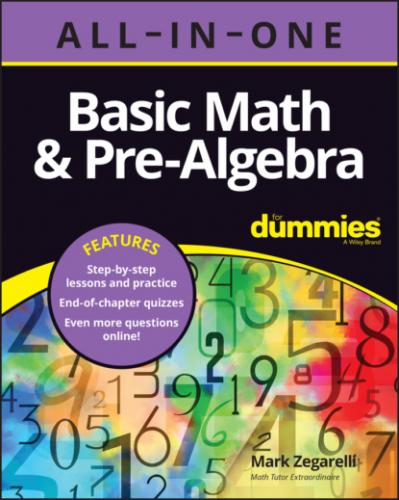Try as you may, you just can’t make a rectangle out of 13 objects. (That fact may be one reason why the number 13 got a bad reputation as unlucky.) Here are all the prime numbers less than 20:
As you can see, the list of prime numbers fills the gaps left by the composite numbers (see the preceding section). Therefore, every counting number is either prime or composite. The only exception is the number 1, which is neither prime nor composite. In Chapter 8, I give you a lot more information about prime numbers and show you how to decompose a number — that is, break down a composite number into its prime factors.
Multiplying quickly with exponents
Here’s an old question whose answer may surprise you: Suppose you took a job that paid you just 1 penny the first day, 2 pennies the second day, 4 pennies the third day, and so on, doubling the amount every day, like this:
As you can see, in the first ten days of work, you would’ve earned a little more than $10 (actually, $10.23 — but who’s counting?). How much would you earn in 30 days? Your answer may well be, “I wouldn’t take a lousy job like that in the first place.” At first glance, this looks like a good answer, but here’s a glimpse at your second ten days’ earnings:
By the end of the second 10 days, when you add it all up, your total earnings would be over $10,000. And by the end of 30 days, your earnings would top out around $10,000,000! How does this happen? Through the magic of exponents (also called powers). Each new number in the sequence is obtained by multiplying the previous number by 2:
As you can see, the notation
You can use exponents on numbers other than 2. Here’s another sequence you may be familiar with:
In this sequence, every number is 10 times greater than the number before it. You can also generate these numbers using exponents:
Four Important Sets of Numbers
In the preceding section, you see how a variety of number sequences extend infinitely. In this section, I provide a quick tour of how numbers fit together as a set of nested systems, one inside the other.
Counting numbers (also called natural numbers): The set of numbers beginning 1, 2, 3, 4 and going on infinitely
Integers: The set of counting numbers, zero, and negative counting numbers
Rational numbers: The set of integers and fractions
Real numbers: The set of rational and irrational numbers
The sets of counting numbers, integers, rational, and real numbers are nested, one inside another. This nesting of one set inside another is similar to the way that a city (for example, Boston) is inside a state (Massachusetts), which is inside a country (the United States), which is inside a continent (North America). The set of counting numbers is inside the set of integers, which is inside the set of rational numbers, which is inside the set of real numbers.
Counting on the counting numbers
The set of counting numbers is the set of numbers you first count with, starting with 1. Because they seem to arise naturally from observing the world, they’re also called the natural numbers:
The counting numbers are infinite, which means they go on forever.
Introducing integers
The set of integers arises when you try to subtract a larger number from a smaller one. For example,
The counting numbers
Zero
The negative counting numbers
Here’s a partial list of the integers:
Like the counting numbers, the integers are closed under addition and multiplication. Similarly, when you subtract one integer from another, the answer is always an integer. That is, the integers are also closed under subtraction.
Staying rational
Here’s the set of rational numbers:
Integers (which include the counting numbers, zero, and the negative counting numbers)
Fractions
Like the integers, the rational numbers are closed under addition, subtraction, and multiplication. Furthermore, when you divide one rational number by another, the answer is always a rational number. Another way to say this is that the rational numbers are closed under division.
Getting real
Even if you filled in all the rational numbers, you’d still have points left unlabeled on the number line. These points are the irrational numbers.
An irrational number is a number that’s neither a whole number nor a fraction. In fact, an irrational number can only be approximated as a non-repeating decimal. In other words, no matter how many decimal places you write down, you can always write down more; furthermore, the
